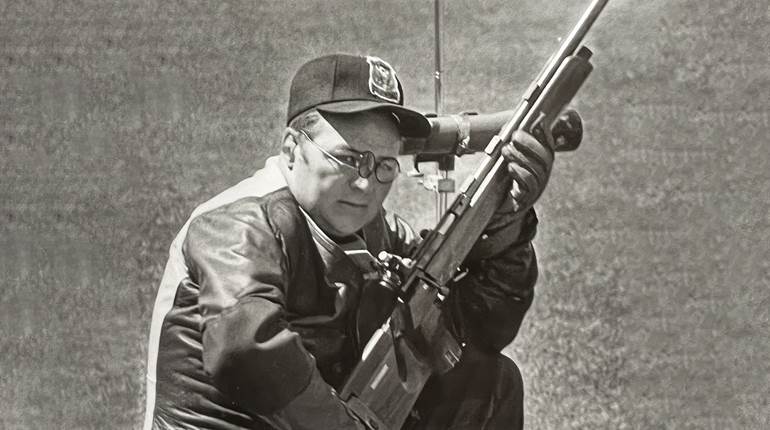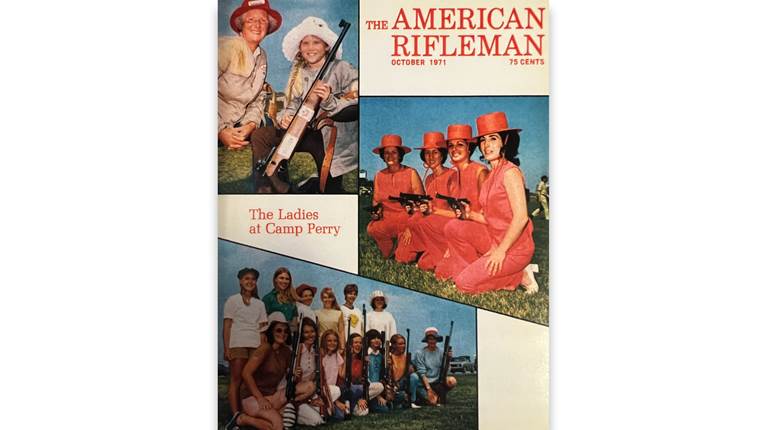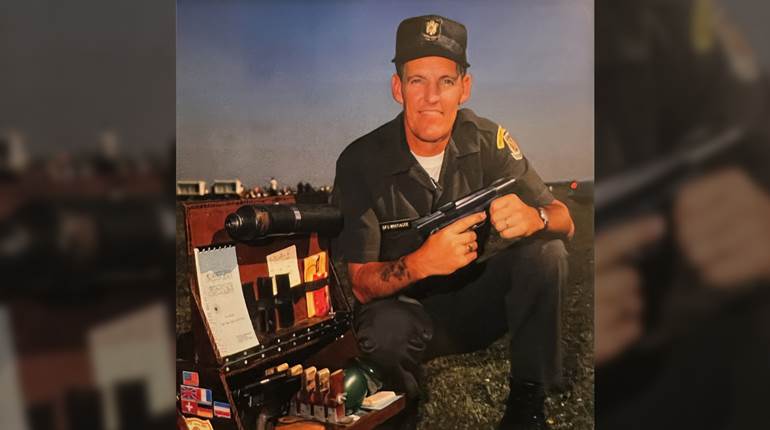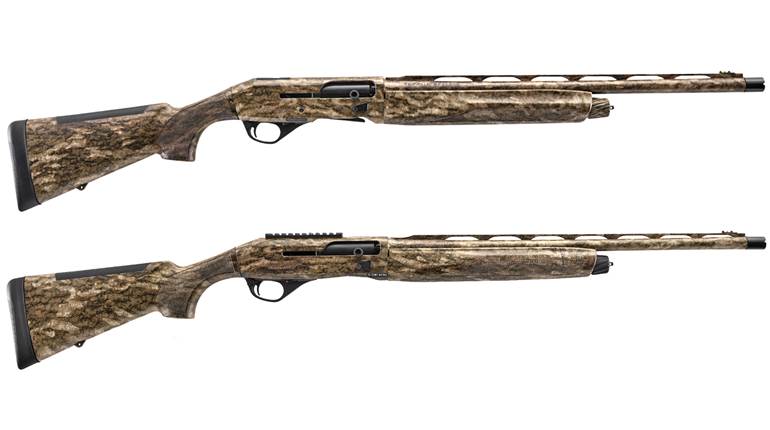
Despite his numerous and diverse accomplishments, Hiram P. Maxim is best remembered as the inventor of the silencer. During his lifetime he was called many names; he called himself…Dr. Shush!
By J. David Truby
First published in American Rifleman, February, 1982
Hiram P. Maxim could have been your kindly next door neighbor, a favorite joke-telling uncle, the nice man who ran the neighborhood store, the president of the local Rotary club or chairman of the county fair committee.

He is known to the world, however, as the inventor of the famous Maxim silencer. Although his Maxim Silent Firearms Co. was not formed until 1908, developmental interest in the device actively began two years earlier. An avid hunter and targeteer, Maxim thoroughly loved shooting, but always the sensitive soul, he also worried that the noise of his gunfire would annoy neighbors. In 1906, he wrote, “it occurred to me one day that there was no need for the noise. Why not do away with it and shoot quietly!”
For two years he sought a practical way to quiet his firearms. His engineering background gave him the reason for the noise — powder gases and sonic crack. But, how to resolve that? His memoirs record how he built valves, vents, by-pass devices, expansion chambers, etc. None worked. Then, one day, during his customary morning bath, his scientist's mind was in a technical daydream, studying the water draining from the tub.

Maxim recalled, “I noticed in the bathtub the miniature whirlpool that forms over the drain hole when the plug is pulled and the water starts to run out. There was the familiar little hole down in the center of the whirl, and it started me thinking that here was an exactly, similar, case to my powder gas and bullet problem. Here was water in a bathtub, the drain plug being pulled out, and yet the water was able to run out, but slowly because it was whirling.
“Why should not the powder gases act the same way as the water, if they were whirled? The whirling would give them centrifugal action precisely as it did the water and cause a 'hole' to form in the center just as the hole formed in the water. In a flash I saw the 'hole' for which I had been looking for nearly two years.
“Immediately, I made a little ‘whirling tube’ which would catch the powder gases as they burst from the muzzle of one of my rifles and whirl it around vigorously In the center I provided a hole for the bullet to pass through but considerably larger than the bullet so it would not touch The gases had no escape except through this central hole. Being central they could not possibly get out until they had slowed down. This of course meant that they must come out gradually and, in consequence, noiselessly. The first time I shot the rifle I was quite excited, I will never forget the sensation I experienced when I found it was quiet! That was the birth of the Maxim Silencer.”
His son, Hiram Hamilton Maxim, described that first silencer, built in 1908, as “a little device that looked like a conch shell stuck on the end of his Winchester .30-30. It worked, in that the gases swirled up into that conch, but it didn't work well. My father was a perfectionist, and he knew he could do better. He junked that design and went back to the work in the shop.”

Among the various silencer designs, the Maxim units are of the expansion type, where hot gases are trapped, swirled and dissipated slowly through a series of chambers, found inside the silencer's outer tube. This allows the gases to lose their heat slowly, cutting the sound of the muzzle blast as the gases finally reach the outside atmosphere. The efficiency of the holding and expansion chambers is obviously the prime factor in the effectiveness of this particular silencer.
“At first, father thought the gases had to be whirled around and confined to reduce the noise level,” H.H. Maxim, a former officer in his father's company, told me. “His first model did just that, keeping the swirling gases inside the silencer chamber. But, he soon realized that he needed only to delay those gases to reduce the report.”
Maxim's next effort was his entry card to the “Ordnance Hall of Fame.” His 1909 model was the world's first truly efficient silencer to be designed, produced and marketed. While it was effective enough at its job of reducing sound, it had two serious drawbacks. First, it was a sealed unit that could not be cleaned nor have its inner materials replaced. Second, because of the concentric passage for the bullet, the silencer unit obliterated the sight picture on the firearm to which it was attached. Once more, Maxim knew he could do better, and he did so the following year.


Most ex perts agree that Maxim's 1910 model was his finest. It was also the most popular sales model and the one which is most commonly encountered now in collections. The major advantage was the off-center passage design which allowed the Model 1910 to be used with the firearm's original sights. Another design modification which improved the Model 1910 was Maxim's addition of a second physical action. In addition to the circular swirling motion, his new design also forced the gases through sloping holes along the length of the silencer tube, cutting noise even more.
perts agree that Maxim's 1910 model was his finest. It was also the most popular sales model and the one which is most commonly encountered now in collections. The major advantage was the off-center passage design which allowed the Model 1910 to be used with the firearm's original sights. Another design modification which improved the Model 1910 was Maxim's addition of a second physical action. In addition to the circular swirling motion, his new design also forced the gases through sloping holes along the length of the silencer tube, cutting noise even more.
The unit was still assembled from stamped sheet steel and still could not "be disassembled. It was advertised and sold for $3.25 per unit, there being no sales restrictions in those innocent days before the reformers, do-gooders, and politicians had private ownership of silencers virtually outlawed here in 1934.
Criminals and nasty users were far from Hiram P. Maxim's mind when he was at work with his designs. He described his successful Model 1910 silencer as being for the man who wants to shoot targets in the backyard without upsetting the neighbors. Others used Maxim-silenced guns to eliminate troublesome garden pests and unwanted alley varmints. Innocent America hadn't yet attached the stigma of criminal use to the device.
H. P. Maxim was in the gun business by birth and interest, one of a trio from this famous family name in ordnance; Sir Hiram S. Maxim, H. P.'s father, invented the first real machine gun, while brother Hudson, H. P.'s uncle, successfully experimented with smokeless gunpowder, the self-propelled torpedo, and a host of other explosive and ordnance items. Hiram P. Maxim, of course, is the father of silencers.
Born on Sept. 2, 1869, Maxim is an unfortunate victim of popular history in that he is remembered only for his firearm silencers. His accomplishments deserve much more. He was also a pioneer in aviation, radio, and motion picture photography. A creative humanist, he wrote and published three books and numerous stories and articles. He also wrote a weekly “science for the layman” column for the King Features newspaper syndicate for many years. Later, on a dare from his sister, he wrote and sold to Hollywood producers the scenario for the Pearl White adventure film The Virgin Paradise.
Described as a cheerful and humorous I man, Maxim had a thick head of hair which grew like a bush above remarkably alert eyes. His wife once said that when he tilted his head sideways he looked just like “an inquisitive fox terrier.” Of average height and weight, he was a healthy, good looking man — unlike the stereotype of an engineer some might imagine, especially one who invents such taboo devices as silencers.
H. P. Maxim was Mr. Silencer, or when he satirized himself in his company sales brochures, he became Dr. Shush. The man was an all-pro genius. At age 15, he entered the School of Mechanical Arts at the Massachusetts Institute of Technology, and was graduated in 1886, at age 17, the youngest student in his class. He then worked as an engineer for several pioneer automotive and electrical companies. He was 38 years old when he decided to “re-career,” devoting full time to the commercial development of history's first successful silencer.
Starting in 1908, his first official business name was the Maxim Silent Firearms Co. But, because of both design and capitalization defects, the company was not successful. The basic Maxim concept was, though, and in 1912, Maxim and his partners formed the Maxim Silencer Co. He had the silencer business pretty much to himself despite a volley of unsuccessful would-be competitors. Interestingly, one of his potential competitors was his father, Sir Hiram S. Maxim, who lived his adult life in England. Sir Hiram was granted a British patent for a device to silence a machine gun's operation just two days prior to his son's own U.S. application for his silencer design. The theoretical and design approaches of father and son were quite different, though. According to the late Maj. F. W. A. Hobart, the noted British firearms historian, neither of these designs went beyond the plans and prototype stage. The son's later designs obviously did.
Despite Hiram P. Maxim's original desire to make the noise of shooting less bothersome to other people, the nasty reality of business quickly and loudly shattered his dream. Some hunters, sportsmen, and considerate plinkers, bought Maxim silencers from local hardware and gun shops, but there were simply too few units being sold to the American public to turn a profit.
“My father was finally convinced that the military was the only mass market,” H. H. Maxim told me during a visit to his home some years ago. “He outlined in a series of handwritten notes the potential military uses — including sharpshooting (sniping), guard harassment, destruction of supplies, and in marksmanship training.
“As a result, his 1912 model silencer was designed with soldiering in mind, and several of the units were tested by the Army with their '03 Springfield, the issue weapon at the time. The silencer quieted the muzzle blast but did nothing to stop the sonic crack of the bullet down range. Gen. Julian S. Hatcher, the legendary small arms expert who conducted the tests, said he was very impressed with the performance of the silencer units, but that the passing of the supersonic bullets sounded ‘as if someone was tearing a rather large bedsheet down range.’”
Gen. Hatcher added in his report, “Bullets fired from those Springfields would ‘crack’ as they passed close to a solid thing like a tree. I fired one of the silenced guns down an old, straight road on the military post, and the bullet cracked each time it passed a telephone pole. The whole thing sounded like a burst of rapid machine gun fire.”
When I told Hamilton Maxim this story, he laughed and told me his father and he had discovered the same thing three years before Gen. Hatcher did. They had a “firing range” which was a stretch of straight road heading away from their Hartford plant.
“I used to fire our silenced Springfield down that road and listen to the ‘crack-crack-crack’ of the bullet as it passed the line of telephone poles. But, when we took it out into an open field, the results were much better and more of what the military had in mind,” he added.
Interestingly, in tests run during the late 1960s at Frankford Arsenal, a Maxim Model 15 silencer, similar to the 1912 unit, was used with an M1903 Springfield rifle. These tests used subsonic ammunition which eliminated the problem noted by Gen. Hatcher. The test report noted that the Springfield rifle and its Maxim silencer were “one of the better units tested at Frankford Arsenal” in the '60s.
But, back in 1912, despite appreciation for the Maxim silencer's effectiveness, the Army wasn't buying in “standard issue” amounts. It was peacetime, with slashed budgets and a tight economy. There was no powerful defense industry lobby and no Pentagon hawks to buzz around Capitol Hill with their appeals for “Stronger Defense; More Weapons!” H. P. Maxim was on his own.
As usual, special mission items like silencers were lumped under “Miscellaneous,” and those who have worked with budgets know what that means: H. P. Maxim sold few silencers to the military. However, some of those few 1912 models went with Gen. John Pershing's expedition into Mexico to chase after Pancho Villa. Sixteen of Pershing's sharpshooters carried the Springfields so-equipped. There is no record that these units were used successfully, but then, there is little to document that any of the Pershing mission was more than a symbolic success. That point also illustrates a major problem about American ordnance research and development.
From Gatling through Maxim through Lewis through Thompson, Johnson, Stoner, Ingram, et. al., the U.S. military has been amazingly close-minded about weapons systems development. Unable to sell to the home government, brilliant American inventors tend to go elsewhere. The full list reads like a Who's Who of Ordnance. Hiram P. Maxim was no exception. His sales agent, Joseph Keegan, easily sold Maxim silencers all over the world, with shipments made to China, Japan, Mexico, England, France, Belgium, Russia, and throughout South America.
The most obvious sales point was the lack of sound. Maxim's favorite demonstration involved mounting a company business card in a special holder set several inches from the muzzle of an unsilenced gun. When the gun was fired, the muzzle blast blew the card to shreds. Then, and always with a dramatic flourish, Maxim would mount his silencer to the rifle and repeat the demonstration. This time there would be a mild click and a neat hole in the center-of the new calling card.
“No noise, no fuss, no muzzle blast,” Hiram Maxim would tell the startled audiences who had to be shown the card for proof the gun was actually fired.
By the time World War I was primed to the shooting point, the Maxim Silencer Co. was producing a line of quality silencers in calibers ranging from .22 through those large enough for machine guns. Despite the popularity of the Maxim silencers, their deployment during World War I was not widespread. Sniping and trench harassment constituted most of the use. A favorite trick was sharpshooting officers, and in this both the Germans and British excelled.
According to the late Maj. Hobart, “The British used Maxim silencers with their Enfield rifles and a few with your Springfields. From what I know, the Germans also used Maxim silencers on their Mauser rifles, although I am not sure if they were actually sold by the Maxim company directly to the Germans.”
Siegfried Hubner, the premier silencer expert in Europe, says that not only were Maxim silencers tested by both the Austrians and the Germans, but that some of the test units were purchased. Although no quantity sales were made, it would have been quite easy for German technicians and machinists to duplicate the Maxim silencer in their own shops. Hubner reports seeing World War I era Mausers and P08 pistols threaded for the Maxim silencer.
During post-World War I hearings in Washington, however, both Hiram P. Maxim and Joseph Keegan hotly denied any allegation that they had sold silencers to the Germans. There was never any hard evidence to suggest otherwise.
When World War I opened in Europe and it became apparent that America would be involved, despite the stance of neutrality taken by President Woodrow Wilson, the Maxim Silencer Co.'s business took off like a rocket. The firm ran production-overtime for military markets eagerly gobbling up firearm silencers, gas grenade casings, automotive mufflers, and parts for bayonet scabbards. They sold at home and abroad; money was made.
By 1917, selected sharpshooters of the American Army were armed with Spring-fields equipped with the Maxim silencer. Some of these men and their weapons made it to Europe for our glorious 180 days of action in the Great War. But there is little in the official record of American silencer success in that action. The enemy was impressed, though, and the Germans called Maxim silencers “The Whispering Death.” These same silencer-equipped Springfields survived their postwar co-somoline nap to serve our snipers again in World War II and Korea.
But, in 1918, after that fighting ended, the profit rocket thudded back-to earth and the company had financially quiet times until 1922, when the industrial silencer market took hold. Hiram Maxim's firearms designs were modified to provide mufflers and silencers for huge industrial machinery. By 1925, the firearm silencer branch was discontinued as being unprofitable, and two years later, the industrial silencer business had the organization back to its wartime success level.
Through the years, the Maxim Silencer Co. produced very large orders for industrial silencers for American Telephone and Telegraph installations and engine silencers for freighters, tankers, and naval vessels, including U.S. fleet submarines. The Maxim engineers also eventually developed the first successful sea-water evaporator, a device which converts sea water to fresh, potable water.
In 1936, with the death of Hiram P. Maxim, his son Hiram Hamilton Maxim became president of the company and remained in that position until the Maxim Silencer Co. was sold to the Emhart Corporation in 1956. At that point, the last Maxim retired from the silencer business. It had been a long, successful run for the family that started the whole quiet business.
In February of 1936, Hiram P. Maxim, then 66 years of age, and his wife left New England by train for a West Coast holiday. He became ill on the train and received medical attention in Chicago. But, a very sick Hiram Maxim was hospitalized in La Junta, Colo., where he died on Feb. 17, 1936.
Shortly after his death an editorial appeared in his “hometown” Hartford Times which gave a sensitive appraisal of Hiram P. Maxim's rare qualities. The editors wrote:
“Hartford had in this generation no keener mind, no man who had a greater catholicity of interest, who sought more eagerly new knowledge in whatever field. Everything about life interested him. He had a vast range of knowledge, yet was utterly unostentatious and gifted with a personal magnetism which caused him to be eagerly sought after as a companion. Life was a romance for him and he had a great zest for everything about it. There was almost no field which his keen and alert mind did not wish to explore, whether it had to do with social science, philosophy, astronomy, industrial development or whatever it might be. Everything interested him, every man's experience, every happening of any nature. He had a boundless enthusiasm for everything that was new. Unlike most scientists he was not content with a purely materialistic view of the universe. In recent lectures he had said that the more one familiarized himself with all that science had discovered, the greater his respect for the orderliness of it all and the stronger the conviction that behind the order must be some supreme force. Knowledge made him neither discontented nor pessimistic. Life remained for him to the end a great and exhilarating adventure. He was a remarkable man, a choice spirit.”
This, then, was the inventor of the silencer. How sad that the device's potential misuse by a few criminals was to cause a virtual ban on its possession and use in the U.S.





































